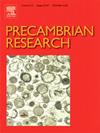塔里木东南部北阿尔金地块~ 790 Ma OIB型基性岩墙:Rodinia破碎重建与地球动力学的启示
IF 3.2
2区 地球科学
Q2 GEOSCIENCES, MULTIDISCIPLINARY
引用次数: 0
摘要
破译塔里木克拉通中保存的罗迪尼亚超大陆的大量岩浆记录,为超大陆演化的地球动力学提供了有价值的见解。在这里,我们报道了塔里木克拉通东南边缘北阿尔金塔格带的~ 790 Ma obb型基性岩脉。锆石U-Pb测年和地球化学分析表明,这些基性岩脉为典型的陆相洪泛玄武岩,呈现出轻稀土元素(LREE)富集模式,Eu亏缺,Nb和Ta轻微富集,sr亏缺。化学和热力学模拟表明,这些基性岩脉起源于俯冲相关流体改造的石榴石尖晶石地幔源,估计部分熔融程度为~ 10%。在随后的岩浆演化过程中,Ol-Cpx-Pl分馏结晶。因此,本文确定的OIB岩脉表明塔里木克拉通在约790 Ma左右从Rodinia裂化。结合塔里木克拉通整体新元古代岩浆记录,以及碎屑锆石年龄和Hf同位素数据,表明塔里木克拉通保存了完整的罗迪尼亚辐合向裂陷过渡的记录。此外,塔里木克拉通、阿尔金中部、祁连—柴达木—东昆仑地块、扬子地块和华夏地块沿罗丁尼亚外围均有850 ~ 740 Ma的超地幔柱破断罗丁尼亚超大陆。羽流活动与环罗迪尼亚俯冲有部分重叠。综上所述,俯冲流体对Rodinia OIB型地幔柱岩浆活动的贡献以及超级地幔柱与Rodinia周围俯冲的时空对比表明,Rodinia破裂地幔柱可能是由Rodinia周围的俯冲引起的。因此,这些发现支持超大陆分裂动力学的“自上而下”模型,强调了俯冲诱发的地幔柱在罗迪尼亚超大陆分裂中的关键作用。该研究表明,俯冲作用驱动超大陆破碎,阐明了地球超大陆旋回中俯冲带和地幔柱如何相互作用。本文章由计算机程序翻译,如有差异,请以英文原文为准。
∼790 Ma OIB type mafic dykes in the North Altyn block, southeastern Tarim: Insights into the reconstruction and geodynamics of Rodinia breakup
Deciphering the extensive magmatic records of the Rodinia supercontinent preserved within the Tarim Craton provides valuable insights into the geodynamics of supercontinent evolution. Here, we report ∼ 790 Ma OIB-type mafic dykes from the North Altyn Tagh belt in the southeastern margin of the Tarim Craton. Zircon U-Pb dating and geochemical analyses reveal that these dykes are typical continental flood basalts, which display light rare earth elements (LREE) enriched patterns with Eu depletion, along with slight enrichment of Nb and Ta and depletion of Sr. Chemical and thermodynamic modelling suggest that these mafic dykes were originated from a garnet-spinel mantle source modified by subduction-related fluids, with an estimated partial melting degree of ∼ 10 %. This was followed by fractional crystallization of Ol-Cpx-Pl during subsequent magma evolution process. Therefore, the here identified OIB dykes indicate that the Tarim Craton rifted from Rodinia at around ∼ 790 Ma. This, together with review of overall Neoproterozoic magmatic records across the Tarim Craton, along with detrital zircon ages and Hf isotopic data, demonstrates that the craton preserves complete record of the transition from Rodinia convergence to rifting. Moreover, the Tarim Craton, Central Altyn, Qilian-Qaidam-East Kunlun, Yangtze and Cathaysia blocks were located along the periphery of Rodinia and all recorded the super-mantle plume that broke the Rodinia supercontinent at 850–740 Ma. The plume activity partially overlapped with circum-Rodinia subduction. Overall, the contribution of subduction fluid to Rodinia OIB type plume magmatism and the spatial–temporal correlation of super mantle plume and circum-Rodinia subduction suggest that the Rodinia breakup mantle plume was likely induced by circum-Rodinia subduction. These findings therefore argue for the “top-down” model for supercontinent breakup dynamics, emphasizing the critical role of subduction-induced mantle plume that broke up the Rodinia supercontinent. This study demonstrates that subduction drives supercontinent fragmentation, clarifying how subduction zones and mantle plumes interact within Earth’s supercontinent cycles.
求助全文
通过发布文献求助,成功后即可免费获取论文全文。
去求助
来源期刊

Precambrian Research
地学-地球科学综合
CiteScore
7.20
自引率
28.90%
发文量
325
审稿时长
12 months
期刊介绍:
Precambrian Research publishes studies on all aspects of the early stages of the composition, structure and evolution of the Earth and its planetary neighbours. With a focus on process-oriented and comparative studies, it covers, but is not restricted to, subjects such as:
(1) Chemical, biological, biochemical and cosmochemical evolution; the origin of life; the evolution of the oceans and atmosphere; the early fossil record; palaeobiology;
(2) Geochronology and isotope and elemental geochemistry;
(3) Precambrian mineral deposits;
(4) Geophysical aspects of the early Earth and Precambrian terrains;
(5) Nature, formation and evolution of the Precambrian lithosphere and mantle including magmatic, depositional, metamorphic and tectonic processes.
In addition, the editors particularly welcome integrated process-oriented studies that involve a combination of the above fields and comparative studies that demonstrate the effect of Precambrian evolution on Phanerozoic earth system processes.
Regional and localised studies of Precambrian phenomena are considered appropriate only when the detail and quality allow illustration of a wider process, or when significant gaps in basic knowledge of a particular area can be filled.
 求助内容:
求助内容: 应助结果提醒方式:
应助结果提醒方式:


